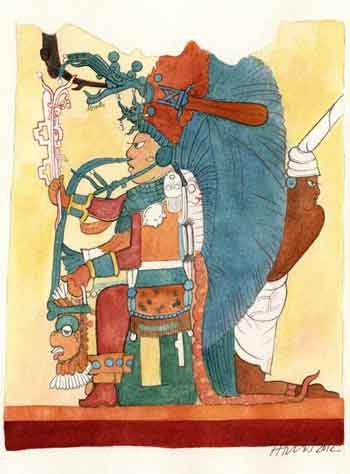当前位置: Language Tips> 双语新闻
 |
|
The earliest known Mayan calendar offers no hint that the world's end is imminent. |
|
The earliest known Mayan calendar has been found in an ancient house in Guatemala and it offers no hint that the world's end is imminent, researchers said Thursday. Rather, the painted room in the residential complex at Xultun was likely the place where the town scribe kept records, scrawling computations on the walls in an effort to find "harmony between sky events and sacred rituals," said the study in the journal Science. The hieroglyphs date back to the ninth century, making them hundreds of years older than the calendars in the Maya Codices, which were recorded in bark-paper books from 1300 to 1521. Some appear to be the 365-day solar calendar, the 584-day cycle of the planet Venus and the 780-day cycle of Mars, said archaeologist William Saturno of Boston University, who led the exploration and excavation. According to Saturno, the writing looks like someone's attempt to sort out a very long math problem, as if on a blackboard. "For the first time we get to see what may be actual records kept by a scribe, whose job was to be official record keeper of a Maya community," Saturno said. "The ancient Maya predicted the world would continue, that 7,000 years from now, things would be exactly like this," he added. "We keep looking for endings. The Maya were looking for a guarantee that nothing would change. It's an entirely different mindset." Furthermore, there is no sign that the much-hyped myth that the Mayan calendar would end in 2012, and with it the world, has any bearing in reality. All that ended in 2012 was one of its calendar cycles, said co-author Anthony Aveni, professor of astronomy and anthropology at Colgate University. "It's like the odometer of a car, with the Maya calendar rolling over from the 120,000s to 130,000," said Aveni. "The car gets a step closer to the junkyard as the numbers turn over; the Maya just start over," he added. (Read by Emily Cheng. Emily Cheng is a journalist at the China Daily Website.) (Agencies) |
研究人员上周四称,考古学家在危地马拉的一处遗址中发现了已知最古老的玛雅历法,里面并未提到2012年是世界末日。 《科学》期刊上的一篇研究报告称,序顿雨林中的这处住宅遗址的墙壁上画有壁画,这里很可能是城镇的抄写员做记录的地方,他在墙壁上潦草地计算着,试图找到“天象和神祭之间的和谐”。 这些象形文字可以追溯到九世纪,比玛雅刻本历法提早了数百年。玛雅刻本于公元1300年到1521年记载在树皮纸做的书上。 率领探勘挖掘的波士顿大学考古学家威廉姆-萨图诺表示,其中一些符号似乎是365天的太阳历,584天的金星周期及780天的火星周期。 萨图诺表示,书写痕迹看起来像是有人试图在黑板上整理出很长的数学问题。 他说:“我们第一次见到可能是抄写人员留下的真实记录,其工作就是玛雅社会的官方记录员。” 他补充说:“古老玛雅预言世界会延续下去,即7000年后情况就像现在一样。” “我们一直在寻找世界末日,玛雅则力寻一切都不会变的保证,心态完全不同。” 此外,大肆炒作的玛雅历法将在2012年结束,以及世界末日会随之到来的说法都没有现实依据。 研究合著者、科尔盖特大学天文学兼人类学教授安东尼-艾凡尼表示,在2012年结束的只是其中一个历法周期。 艾凡尼说:“玛雅历法就像汽车的里程表从12万公里翻到了13万公里。” “随着数字的升级,汽车离报废又近了一步,但玛雅历法只是又重新开始了。“ 相关阅读 (中国日报网英语点津 Julie 编辑:陈丹妮) |
|
Vocabulary: scribe: 抄写员 hieroglyph: 秘密符号,图画文字 |
上一篇 : 美离婚“女养男”呈上升趋势
下一篇 : 《雷锋日记》节选十八(双语对照)
电话:8610-84883645
传真:8610-84883500
Email: languagetips@chinadaily.com.cn